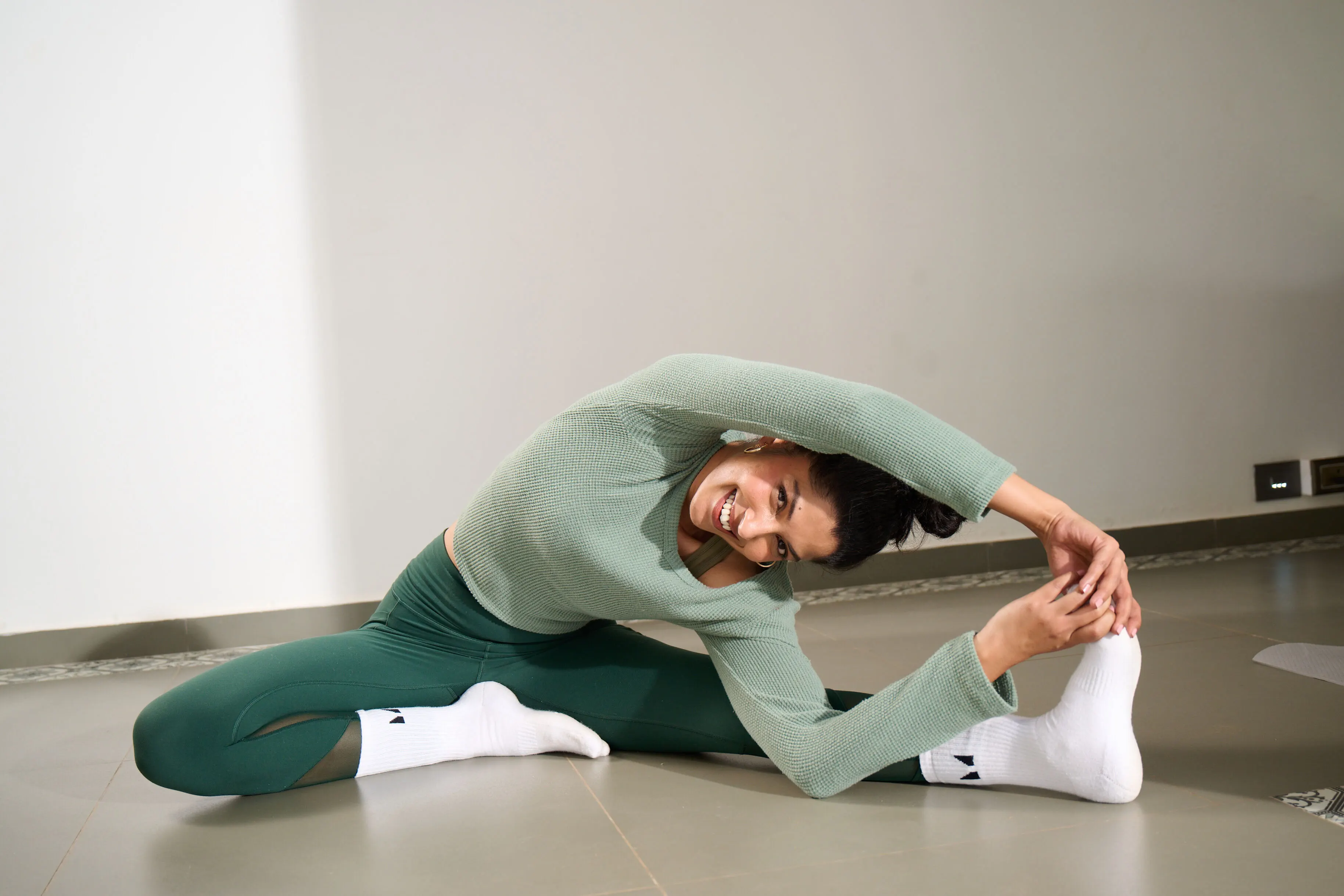What is Pasasana?
Pasasana, also known as the "Noose Pose," is a challenging seated twisting posture in yoga, usually practiced in the advanced stages of the Ashtanga Yoga sequence. In this pose, you have to squats low with the feet together, wrap the arms around the knees, and bind the hands behind the back, resembling a noose. Pasasana helps improve spinal flexibility, stimulates digestion, and strengthens the legs and core muscles. It also encourages deep breathing, balance, and focus. Due to its complexity, it requires both strength and flexibility in the shoulders, hips, and ankles.
Position type: Seated
Posture type: Squat and Twist
Ideal for: Flexibility
Targets: Back, abdomen, hips and ankles
Pose level: Advanced
How to prepare for Pasasana?
Pasasana is an advanced posture that requires time and practice to build up to it. Regular practice of the below exercises will help you access Pasasana gradually.
Hip and ankle flexibility: Pasasana involves a deep squat and a twist, so it's essential to prepare by loosening the hips and ankles. Malasana (Garland Pose) is an excellent preparatory pose to open the hips and get comfortable in a deep squat position. Apart from this, practicing poses like downward-facing dog, low lunge, and bound angle pose can improve flexibility in the hips and ankles, making it easier to access Pasasana.
Spinal mobility and twist: Since Pasasana involves a deep spinal twist, it's helpful to prepare the spine with poses like Vakrasana, Ardha Matsyendrasana, Marichyasana C and revolved side angle pose to increase mobility and ease into the twist.
Balance: Improve balance to hold Pasasana with stability. Tree pose, chair pose, and eagle pose can help build the necessary balance for maintaining the deep squat and twist position.
How to do Pasasana
Getting into the posture:
- Begin in a low squat position with your feet together or hip-width apart. Keep your heels grounded on the mat. If your heels don't touch the ground, you can place a folded blanket or block under them for support.
- Draw your navel toward your spine to engage your core muscles and maintain balance in the squat.
- Inhale to lengthen your spine, and as you exhale, twist your torso to the right, bringing your left arm around the outside of your right knee. Reach your left hand around your back.
- Reach your right arm behind your back, attempting to clasp your left wrist or fingers. If you cannot reach, use a yoga strap or towel between your hands.
- Keep your chest lifted and your spine long. Stay in the twist while grounding through your heels and focusing on your breath.
- Hold the pose for 5-10 breaths.
Getting out of the posture:
- First gently release the bind and then sit down in the Staff Pose for a minute. Then repeat the twist on the left side.
Key Alignments in Pasasana
- Keep your heels firmly on the mat to ensure stability in the squat. If your heels lift, use a block or blanket under them for support to maintain proper alignment.
- Ensure your knees track in the same direction as your toes throughout the twist to protect the knees and maintain balance in the lower body.
- Focus on lengthening your spine before twisting, keeping the chest open and shoulders relaxed. This prevents rounding of the back and allows for a deeper, more effective twist.
What are the Benefits of Pasasana? Pasasana deeply stretches and strengthens the ankles, thighs, and hips, improving flexibility and mobility in these areas. The deep spinal twist helps release tension in the back, enhancing spinal flexibility and promoting better posture. By stimulating digestion through the abdominal twist, Pasasana can aid in relieving bloating and detoxifying the body. The pose also requires focus and balance, helping improve mental clarity and concentration. Additionally, Pasasana strengthens the core and enhances overall body awareness, making it a great posture for developing both physical stability and mindfulness.What are the Contraindications of Pasasana? Individuals with knee injuries or pain should avoid Pasasana, as the deep squat can put strain on the knee joints. Those with ankle issues or limited ankle flexibility may find the pose uncomfortable and risk injury and should ideally avoid the pose. Spinal injuries or severe back pain, especially in the lower back, can also be aggravated by the deep twist involved in Pasasana. Additionally, those with high blood pressure or dizziness may find it challenging to maintain balance and should practice with caution.Counter poses of PasasanaAlways do the asana on both sides. After completing each side (or directly after both sides), gently bend to either side to ensure balance in the body. Practice Seated Forward Bend for a counter movement to the back or Child’s Pose for a few minutes. You can also sit in Dandasana or Staff Pose for a few minutes. Variations of Pasasana Easy Modifications for Pasasana:
- If your heels don’t touch the ground, place a folded blanket or yoga block under them to help maintain balance and proper alignment.
- If you cannot bind your hands behind your back, use a yoga strap or towel to bridge the gap, allowing you to gently ease into the twist without straining your shoulders or arms. You can also practice near a wall to help you twist initially.
Advanced Variations for Pāsāsana:
- For a more intense twist, try bringing the opposite elbow to the outside of the knee instead of the arm, and work on tightening the bind by clasping the wrists.
- For advanced practitioners, practice the twist while in a toe squat (lifting the heels off the mat), which increases the challenge for balance and deepens the stretch.
Advice for Beginners For beginners practicing Pasasana, focus on maintaining balance and stability in the squat before attempting the twist. If your heels lift off the ground, use a block or blanket to support them. Don’t worry about binding the hands right away. Your focus should be on lengthening the spine and gently twisting to your ability. You can use a strap to help with the bind or keep the arms open for a lighter twist. Practice preparatory poses like Malasana and seated twists regularly to build flexibility and mobility. Most importantly, move slowly and listen to your body to avoid strain. Shvasa Tips for Pasasana
- If the twist feels too intense, practice with a shorter bind or simply focus on twisting without binding the hands.
- Activate your core muscles to help stabilize your body during the twist. This engagement will support your lower back and allow for a deeper, more controlled rotation.
- Maintain steady, deep breaths throughout the pose. Use your inhalations to lengthen the spine and your exhalations to deepen the twist.
Learn how to practice Pasasana the right way, with modification and props, from an experienced teacher LIVE on Shvasa. Meta Description: How to do the Pasasana, with step-by-step instructions, benefits, contraindications and modifications. Summary: Pasasana, also known as the "Noose Pose," is a challenging seated twisting posture in yoga. Learn how to practice safely with expert yoga teachers. FAQs:
- What are the Benefits of Pasasana?
Pasasana deeply stretches and strengthens the ankles, thighs, and hips, improving flexibility and mobility in these areas. The deep spinal twist helps release tension in the back, enhancing spinal flexibility and promoting better posture. By stimulating digestion through the abdominal twist, Pasasana can aid in relieving bloating and detoxifying the body. The pose also requires focus and balance, helping improve mental clarity and concentration.
- What are the Contraindications of Pasasana?
Individuals with knee injuries or pain should avoid Pasasana, as the deep squat can put strain on the knee joints. Those with ankle issues or limited ankle flexibility may find the pose uncomfortable and risk injury and should ideally avoid the pose.
- What is Pasasana?
Pasasana, also known as the "Noose Pose," is a challenging seated twisting posture in yoga, usually practiced in the advanced stages of the Ashtanga Yoga sequence. In this pose, you have to squats low with the feet together, wrap the arms around the knees, and bind the hands behind the back, resembling a noose. Pasasana helps improve spinal flexibility, stimulates digestion, and strengthens the legs and core muscles.
- How to do Pasasana
- Begin in a low squat position with your feet together or hip-width apart. Keep your heels grounded on the mat. If your heels don't touch the ground, you can place a folded blanket or block under them for support.
- Draw your navel toward your spine to engage your core muscles and maintain balance in the squat.
- Inhale to lengthen your spine, and as you exhale, twist your torso to the right, bringing your left arm around the outside of your right knee. Reach your left hand around your back.
- Reach your right arm behind your back, attempting to clasp your left wrist or fingers. If you cannot reach, use a yoga strap or towel between your hands.
- Keep your chest lifted and your spine long. Stay in the twist while grounding through your heels and focusing on your breath.
- Hold the pose for 5-10 breaths.
- First gently release the bind and then sit down in the Staff Pose for a minute. Then repeat the twist on the left side.















.jpg)












%201.png)

%201.svg)






%201.svg)